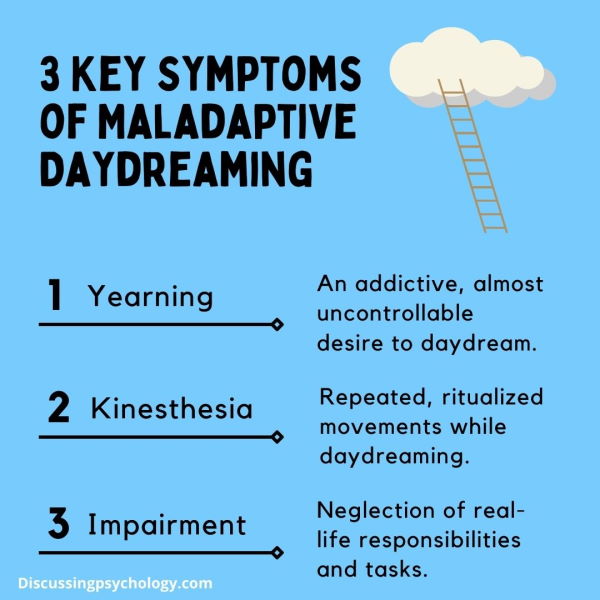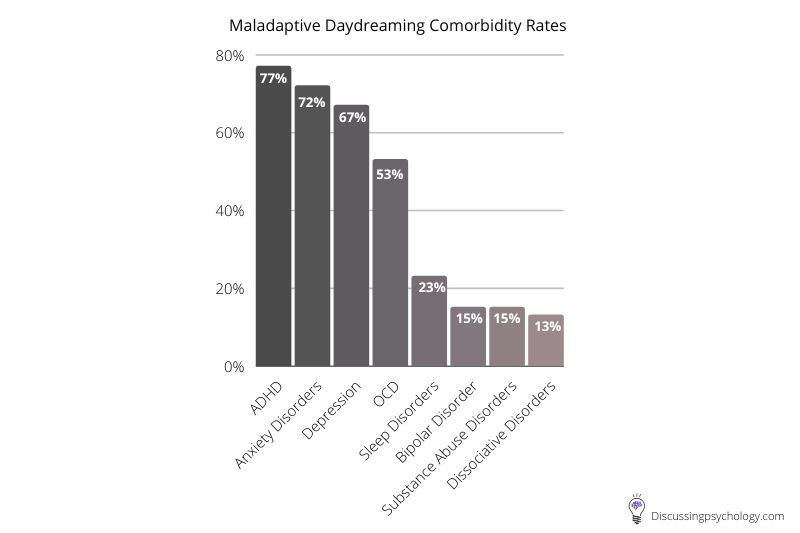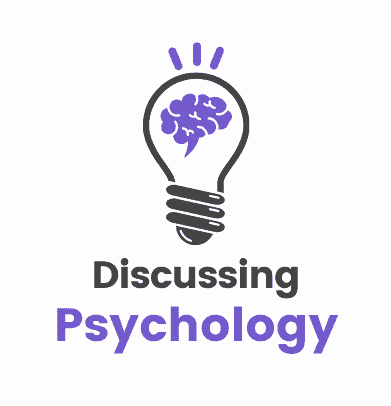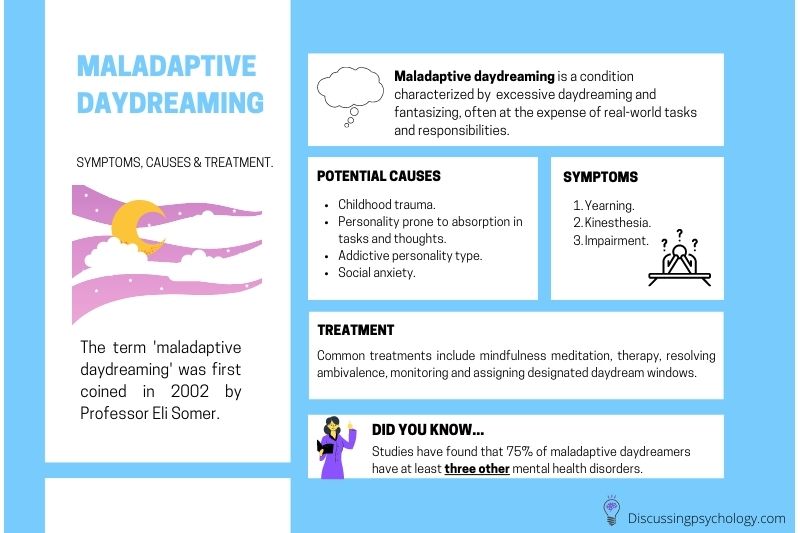Maladaptive daydreaming (MD) emerged as a relatively new condition in the realm of mental health, with research into it commencing in the 21st century.
For individuals experiencing this condition, the urge to indulge in daydreams can be so overpowering that it can significantly disrupts their daily functioning.
Yet, what exactly constitutes maladaptive daydreaming? How does one develop an addiction to their own daydreams? And is there effective treatment available for this condition?
Maladaptive Daydreaming: Definition and Symptoms
Maladaptive daydreaming is when a person becomes compelled to spend hours at a time engaged in vivid, elaborate fantasy daydreams. The urge to daydream and the time it consumes lead to severe distress and difficulty living a normal life. Current research suggests maladaptive daydreaming could affect about 2.5% of the population.
Everyone has daydreams, and occasionally wishing you could spend your time in an idealized fantasy version of your life is a fairly common experience.
So when do normal levels of fantasizing cross the line into being maladaptive?
Researchers into maladaptive daydreaming differentiate the condition from normal experience by assessing three main factors:
- Yearning
- Kinesthesia
- Impairment
Let’s take a look at each factor in more detail below.

Yearning
People with MD find their daydreams very enjoyable, sometimes spending more than half of their waking hours living out stories that would be impossible in their real lives.
This intense pleasure creates a strong yearning to spend time in the dream, often leading to daydreams becoming an uncontrollable compulsion.
Kinesthesia
Maladaptive daydreaming is almost always facilitated by repeated, ritualized movements such as pacing, hand movements, or even acting out the movements of the daydream.
This, combined with the use of music or other media, helps bring about deeper immersion in the fantasy.
Impairment
The hours spent in daydreams inevitably causes other aspects of life to become neglected. Many with MD find themselves socially isolated, unable to hold down a job, and unable to progress with real life due to the time and effort spent dreaming.
Often the urge to daydream is so overpowering that concentration starts to suffer and sleep becomes difficult.
Feeling of guilt and shame about the condition, fear that one’s fantasies will be discovered, and concerns about one’s inability to control one’s own thoughts are also common symptoms.
Maladaptive Daydreaming Diagnosis
Although MD isn’t yet recognized in any of the major classification manuals for mental health disorders, it can be diagnosed and assessed using a specifically-designed questionnaire known as the Maladaptive Daydreaming Scale.
Related: We've created an online test based on the official 16-Point Maladaptive Daydreaming Scale. To take this free test, follow this link here: Maladaptive Daydreaming Test
What Causes Maladaptive Daydreaming?
Researchers of MD are still unraveling the exact causes and risk factors, but there is a clear link between experiencing traumatic circumstances as a child and developing maladaptive daydreaming later in life.
When a child is forced to endure circumstances such as abuse, neglect, or intense bullying, they might turn to imagination as a means of comfort or escape.
In extreme cases, this coping mechanism persists into adult life, becoming the individuals only way of responding to difficulty.
Other factors thought to be involved in the development of MD include:
- Capacity for absorption: Absorption is one’s ability to become totally engrossed in a task, activity or train of thought. If you’ve ever been so ‘in the zone’ reading a book or driving that you didn’t realize hours have passed, you know all about it.
Absorption is a state some people find easier to achieve than others, and while it is not necessarily a bad thing, being readily able to immerse yourself in fantasy is a natural prerequisite for the development of MD. - Addiction sensitivity: Since MD is a form of addictive behavior, finding it naturally hard to resist temptation and having a compulsive mindset make it all the more likely to develop. Addiction to fantasy is a term used in MD research to describe how willing individuals are to engage in fantasies to the point of addiction.
- Social anxiety: Research has also found a link between MD and levels of anxiety around socializing. Since maladaptive daydreams usually cannot occur while other people are present, anxiety and shyness around others goes hand in hand with spending time daydreaming alone.
Taken together, these factors suggest that a survivor of childhood trauma who has a vivid capacity for imagination, has an addictive personality, and is currently experiencing social isolation and anxiety would be an ideal candidate for the development of maladaptive daydreaming.
Often the content of maladaptive daydreams reflects the areas in which a person’s real life has been lacking.
A survivor of neglect as a child may imagine themselves at the center of a loving family, while a narcissist who craves recognition may engage in power fantasies involving dominance or revenge against their enemies.
Is Maladaptive Daydreaming Linked to other Mental Illnesses?

Maladaptive daydreaming has high rates of comorbidity with several other conditions and mental illnesses. These include:
- Attention-deficit hyperactivity disorder (ADHD)
- Anxiety disorders
- Obsessive-compulsive disorder (OCD)
- Narcissistic personality disorder
- Depression
- Autism
The exact nature of the relationship is not always understood: MD could arise as a coping mechanism for other disorders, the distress it causes may lead to the development of other conditions, or it may share fundamental mental traits and risk factors with other conditions.
How is Maladaptive Daydreaming Treated?
No standardized method of treatment for maladaptive daydreaming has currently been developed, but individual case studies have shown that several psychological tools and techniques can help manage the condition.
These include the following:
- Mindfulness meditation: Mindfulness teaches people to be fully present in the moment and helps develop the ability to disengage from thoughts rather than always acting upon them. It therefore allows patients with MD to focus on their real lives and resist the urge to daydream.
- Resolving ambivalence: Since MD produces enjoyment as well as distress, patients may be, on some level, reluctant to let go of their daydreams. To fully recover from the condition, these mixed feelings must be resolved and the person must commit to change. Techniques from a style of therapy called Motivational Interviewing (MI) have been shown to help with this.
- Monitoring: Keeping daily journals and staying accountable to others can help to identify triggers and vulnerabilities that lead to MD.
- Limited daydreaming: Only allowing yourself to daydream at a certain time of day can limit its impact on your life.
Talking to a therapist about maladaptive daydreaming is nothing to feel ashamed of. BetterHelp has over 30,000 licensed therapists who can provide a safe space to explore your feelings, deal with compulsive thoughts and help challenge unhealthy coping mechanisms. Prices starting at $65/week. To get started with BetterHelp online therapy, click here to fill in their brief questionnaire. Discussing Psychology readers get 15% off their first month with BetterHelp.
Daydreaming Without the Maladaptation
As a final note on the treatment of MD, it’s worth remembering that there is nothing intrinsically negative about the daydreams themselves.
Imagination is a wonderful thing, and its capacity to comfort and entertain should not be discounted.
It is only when daydreaming becomes one’s sole coping mechanism for dealing with stress, and it therefore becomes a compulsion, leading to distress and impairment. If one was able to experience vivid and highly enjoyable daydreams without the adverse effects on the rest of one’s life, there would be no issue.
Researchers do think it possible to experience immersive daydreaming: maladaptive daydreaming without the impairment and distress. Far from being a disorder, this capacity for immersion and imagination is highly beneficial.
And so a crucial goal of treatment for MD is to deal with the underlying unmet needs that prompted the need for daydreams as an escape. If this can happen then it might be possible for people with MD to enjoy all the benefits of their daydreams in a more measured way that does not hinder their waking lives.
Next Steps
BetterHelp has over 30,000 licensed therapists who can provide a safe space to explore your feelings, deal with compulsive thoughts and help challenge unhealthy coping mechanisms.
Prices starting at $65/week. To get started with BetterHelp online therapy, click here to fill in their brief questionnaire.
- Bigelsen, J., Lehrfeld, J., Jopp, D. and Somer, E., 2016. Maladaptive daydreaming: Evidence for an under-researched mental health disorder. Consciousness and Cognition, 42, pp.254–266. https://www.sciencedirect.com/science/article/abs/pii/S1053810016300460
- Somer, E. (2018). Maladaptive daydreaming: Ontological analysis, treatment rationale; a pilot case report. Frontiers in the Psychotherapy of Trauma and Dissociation, 1, 1–22. https://www.researchgate.net/publication/322152657_Maladaptive_Daydreaming_Ontological_Analysis_Treatment_Rationale_a_Pilot_Case_Report
- Somer, E. (2020, September 28) Treatment for maladaptive daydreaming. [Video file]. https://www.youtube.com/watch?v=u9ZXH1c87AU&ab_channel=SomerClinic
- Somer, E., Abu-Rayya, H., & Brenner, R. (2020). Childhood trauma and maladaptive daydreaming: Fantasy functions and themes in a multi-country sample. Journal of Trauma & Dissociation, 22(3), 288–303. https://doi.org/10.1080/15299732.2020.1809599
- Somer, E. & Herscu, O. (2017). Childhood trauma, social anxiety, absorption and fantasy dependence: Two potential mediated pathways to maladaptive daydreaming. Journal of Addictive Behaviors,Therapy and Rehabilitation, 06(04). https://doi.org/10.4172/2324-9005.1000170
- Somer, E., Lehrfeld, J., Bigelsen, J., & Jopp, D. (2016). Development and validation of the Maladaptive Daydreaming Scale (MDS). Consciousness and Cognition, 39, 77–91. https://doi.org/10.1016/j.concog.2015.12.001
- Somer, E., Soffer-Dudek, N., & Ross, C. (2017). The comorbidity of daydreaming disorder (maladaptive daydreaming). Journal of Nervous and Mental Disease, 205(7), 525–530. https://doi.org/10.1097/nmd.0000000000000685
- Somer, E., Somer, L. and Jopp, D., (2016). Parallel lives: A phenomenological study of the lived experience of maladaptive daydreaming. Journal of Trauma & Dissociation, 17(5), pp.561-576. https://www.researchgate.net/publication/297608041_Parallel_Lives_A_Phenomenological_Study_of_the_Lived_Experience_of_Maladaptive_Daydreaming

